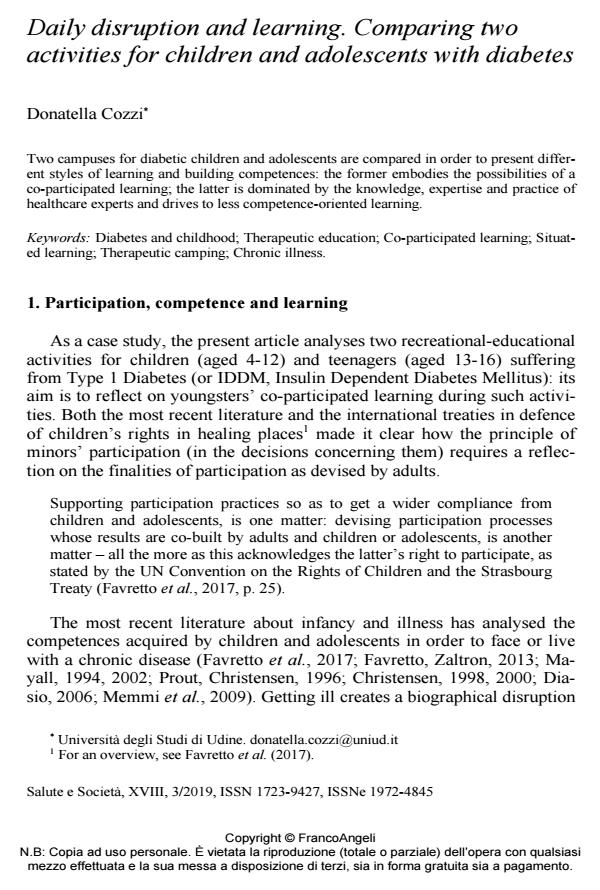Daily disruption and learning. Comparing two activities for children and adolescents with diabetes
Journal title SALUTE E SOCIETÀ
Author/s Donatella Cozzi
Publishing Year 2019 Issue 2019/3 Language English
Pages 10 P. 25-34 File size 138 KB
DOI 10.3280/SES2019-003003
DOI is like a bar code for intellectual property: to have more infomation
click here
Below, you can see the article first page
If you want to buy this article in PDF format, you can do it, following the instructions to buy download credits

FrancoAngeli is member of Publishers International Linking Association, Inc (PILA), a not-for-profit association which run the CrossRef service enabling links to and from online scholarly content.
Two campuses for diabetic children and adolescents are compared in order to present different styles of learning and building competences: the former embodies the possibilities of a co-participated learning; the latter is dominated by the knowledge, expertise and practice of healthcare experts and drives to less competence-oriented learning.
Keywords: Diabetes and childhood; Therapeutic education; Co-participated learning; Situated learning; Therapeutic camping; Chronic illness.
- Bateson G. (1976). Verso una ecologia della mente. Milano: Adelphi (orig. ed.: Step to an Ecology of Mind. Chicago: University of Chicago Press, 1972).
- Bonetti R. (2018). Apprendimento a km zero. Un caso di ricerca applicata nel terziario avanzato. Roma: CISU.
- Bury M. (1982). Chronic illness as biographical disruption. Sociology of Health & Illness, 4(2): 167-182.
- Christensen P. (1998). Difference and similarity: How children’s competence is constituted in illness and its treatment. In: Hutchby I., Moran-Ellis J., editors, Children and social competence. Arenas of action. New York: Routledge.
- Christensen P. (2000). Childhood and the cultural constitution of vulnerable bodies. In: Prout A., Campling J., editors, The body, childhood and society. Basingstoke: Macmillan.
- Cornolti S. (2016). ‘Diventare grandi’. Esperienza residenziale/educazionale dei ragazzi affetti da diabete 1, tesi di laurea in Infermieristica, relatore: Nadia Urli, correlatore: Tania Lanfrit, Università degli Studi di Udine, Dipartimento di Scienze Mediche e Biologiche, a.a. 2015-16.
- Cozzi D., Diasio N. (2017). Embodying illness and managing the uncertainty. Miscellanea Anthropologica et Sociologica, 18(3): 50-64.
- Diasio N. (2006). Adultes et enfants entre pouvoir et insoumission. In: Sirota R., editor, Eléments pour une sociologie de l’enfance. Rennes: Presses Universitaires de Rennes.
- Favretto A.R., Zaltron F. (2013). Mamma non mi sento tanto bene. La salute e la malattia nei saperi e nelle pratiche infantili. Roma: Donzelli.
- Favretto A.R., Fucci S., Zaltron F. (2017). Con gli occhi dei bambini. Come l’infanzia affronta la malattia. Bologna: il Mulino.
- Hanghøj S., Boisen K.A. (2013). Self-reported barriers to medication adherence among chronically ill adolescents: a systematic review. Journal of Adolescent Health, 54(2): 121-138.
- Hunter H.L., Rosnov D.L., Koontz D., Roberts M.C. (2006). Camping programs for children with chronic illness as a modality for recreation, treatment, and evaluation: an example of a mission-based program evaluation of a diabetes camp. Journal of clinical psychology in medical settings, 13(1): 64-77.
- International Diabetes Federation (2015). IDF Diabetes Atlas, 7 ed. Brussels: International Diabetes Federation. --Available at: http://www.diabetesatlas.org/resources/2015-atlas.html (28/12/2018).
- Colombini M.I., Schivalocchi E. (2013). The Impact of Diabetes on Adolescent Development: The Experiences of Teenagers with Diabetes attending a Summer Camp. Adolescent Psychiatry, 3(3): 245-251.
- Lave J., Wenger E. (1991). Situated Learning: Legitimate Peripheral Participation. Cambridge: Cambridge University Press (trad. it.: L’apprendimento situato. Trento: Erikson, 2006).
- Lipari D. (2007). Introduzione. In: Wenger E., McDermott R., Snyder W.M., Coltivare comunità di pratica. Milano: Guerini e Associati.
- Mayall B. (1994). Negotiating health: Primary School children at home and school. London: Cassel.
- Mayall B. (2002). Towards a sociology for childhood: Thinking from children’s lives. Buckingham: Open University Press.
- Memmi D., Guillo D., Martin O. (2009). La tentation du corps. Paris: Éditions de l’École en Sciences Sociales.
- Peters A., Laffel L., American Diabetes Association Transitions Working Group (2011). Diabetes Care for Emerging Adults: Recommendations for Transition from Pediatric to Adult Diabetes Care Systems. Diabetes care, 34(11): 2477-2485.
- Piras E.M., Miele F. (2017). L’educazione terapeutica come incontro clinico prolungato: il caso dei campi scuola per giovani diabetici. Salute e Società, 3: 134-150. DOI: 10.3280/SES2017-00301
- Prout A., Christensen P.H. (1996). Hierarchies, boundaries and symbol: Medicine use and the cultural performance of childhood sickness. In: Bush P., Trakas D.J., Sanz E.J., Wising T.R., Vaskilampi L., Prout A., editors, Children medicine and culture. New York-London: Haworth Press.
- Enfants et adolescents face à la maladie chronique : le cas du diabète de type 1 Virginie Vinel, Nicoletta Diasio, Lydie Bichet, in Revue des politiques sociales et familiales /2021 pp.89
DOI: 10.3917/psf.138.0089 - Children and Adolescents Faced with Chronic Illness: The Case of Type 1 Diabetes Virginie Vinel, Nicoletta Diasio, Lydie Bichet, in Revue des politiques sociales et familiales /2022 pp.175
DOI: 10.3917/rpsf.145.0175
Donatella Cozzi, Daily disruption and learning. Comparing two activities for children and adolescents with diabetes in "SALUTE E SOCIETÀ" 3/2019, pp 25-34, DOI: 10.3280/SES2019-003003